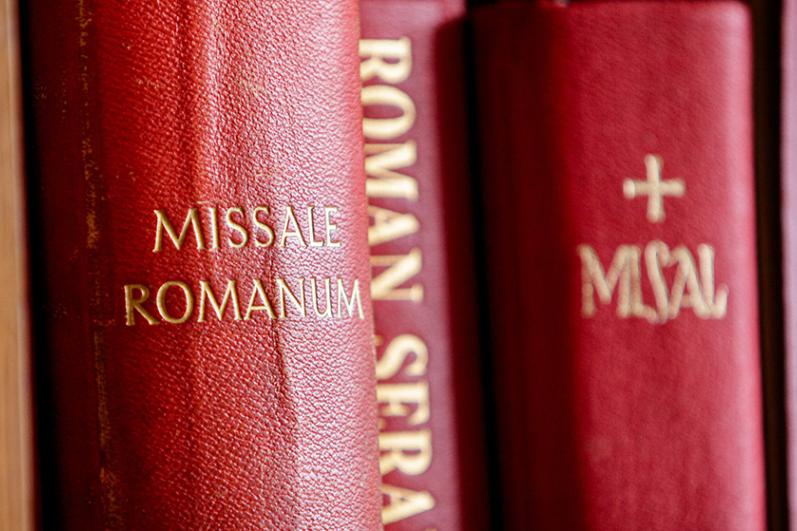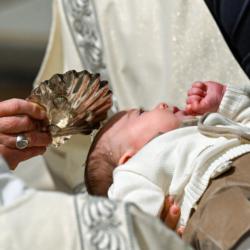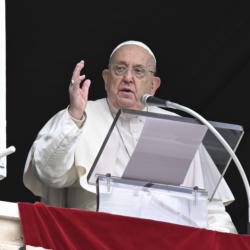'The Roman Missal'
In sacristies and sanctuaries of Roman Catholic churches there are books. Sometimes the essential ones only; sometimes a mini-library -- essentials plus. In the next several columns, the liturgy's library, at least some of it, will be our topic.
"The Roman Missal" is probably the most noticeable of all the liturgical books. It is generally present throughout the Mass, seen at the celebrant's chair, and at the altar. The version we are presently using is now over a decade old.
Since this volume contains the prayers for the Mass, it is the proper launch place for a series about the liturgical books. After all, the Mass is the most important activity of the Church's life. Before and above anything else the Church does, the worship of the Father, through the Son, in the Holy Spirit is the primary mission of the Church.
For our purposes, we'll look at the Missal in three sections: front, center, and back.
The center has all the parts of the Mass for the assembly's payer at each Mass. That means the clergy's parts and the people's parts are all there and, for the most part, what we need for the prayers for the "ordinary" of non-changing parts. The non-changing parts have options, but those are all there.
The front section has the prayers for all the Sundays, most of the solemnities in the General Calendar, and the weekdays of the reserved season, i.e., Easter, Lent, Christmas, and Advent. Before those prayers are several documents that give us directions about the preparation, the celebration, and what's needed for Mass; it also has the General Calendar of various celebrations.
The back section has the prayers for the saints' days; the prayers for the sacraments and sacramentals that may be celebrated during Mass; and a splendid array of prayers for Mass fitting various needs and occasions. An array of indices complete the back section.
Much of the Missal is reprinted in your parish's missalette, with which you might "follow along" during Mass. You can easily see that nowhere near the content of the Missal could fit into a missalette. That's why sometimes prayers will be prayed that you cannot find in your missalette. Recently, after Mass in one of our parishes, a very attentive parishioner demanded that the priest show her the prayer (Eucharistic Prayer) he proclaimed as being in the Missal (it was not in her missalette). He had prayed one of the four Eucharistic Prayers for Masses for Various Needs and Occasions. They were both correct! He had used a prayer in the Missal; she discovered it wasn't in the missalette.
The front section contains a very long document -- its official title is the "General Instruction on the Roman Missal." It is a detailed description of how Mass (in various forms) is to be celebrated. Commonly abbreviated GIRM, and pronounced "germ," it sets out the "rules and regulations" -- it is actually liturgical law -- for the proper celebration of Mass. We priests are supposed to be familiar with its contents, and it is supposed to direct our steps and those of the gathered assembly through this ultimate prayer.
Most of the text of the Missal is in black; however, there is a good deal of red text as well. These are called "rubrics" because rubrus, whence comes the word, is the Latin for red. There are many of them. Some are for the entire assembly; some are for a particular minister (bishop, priest, deacon, reader, acolyte, server, cantor, psalmist, etc.); some may be for a group, such as the choir. Every member of the assembly has a necessary part to pray in this sacred action. It is not proper to "leave it all to Father."
Sometimes you may notice an "abbreviated" version of the Missal being brought by a server or, if necessary, by the priest himself. This volume contains and is titled: "Excerpts from the Roman Missal." It contains most of the parts of the Mass that the principal celebrant ought to pray from the presidential chair. It was published in response to a loudly made request for "mercy for servers" who found carrying and supporting the complete Missal during the principal celebrant's prayers to be difficult (too heavy) or awkward (too large). This volume, like "The Roman Missal" available in both regular and large print versions, is an answer to that plea.
"The Roman Missal" and its substantial content, with which all of us priests especially need to be familiar, provides the entire Church gathered each Sunday and each day around the Lord's tables of Word and Eucharist a sure means of offering our common prayer to the Father, through the Son, in the Holy Spirit.



















